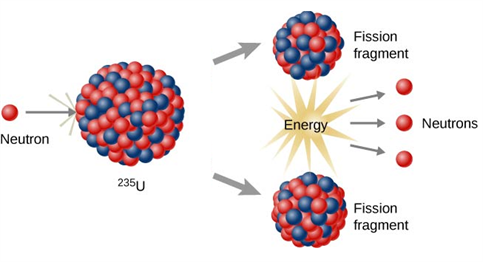PDF chapter test TRY NOW
In 1939, German scientists Otto Hahn and F. Strassman discovered the process of nuclear fission. When a uranium nucleus is bombarded with a neutron, it splits up into two smaller nuclei of equivalent mass, emitting a few neutrons and some amount of energy.

Nuclear fission
Nuclear fission is the process of splitting or breaking up a heavy nucleus into two smaller nuclei with the release of a huge quantity of energy and a few neutrons.
Example:
Nuclear fission of a uranium nucleus (U^{235})

Splitting of a uranium nucleus
_{92}U^{235} + _{0}n^{1} \rightarrow _{56}Ba^{141} + _{36}Kr^{92} + 3 _{0}n^{1} + Q (energy)
The average energy released in each process of nuclear fission is about 3.2 \times{10^{-11}} J.
Features of fission reaction:
Some of the salient features of a fission reaction are
Some of the salient features of a fission reaction are
- A fission reaction occurs if the nucleus of a heavy atom (U\ -235) is bombarded with a slow-moving neutron.
- Fast-moving neutrons cannot produce a fission reaction.
- The products of a fission reaction are a lighter nucleus of atomic mass ranging from 85 to 104, a heavy nucleus of atomic mass ranging from 130 and 149 with two or three neutrons.
- Fission reaction is accompanied by the release of an enormous amount of energy in the form of light and heat.
- Sometimes, fission reaction produces γ-radiations of a very shorter wavelength.
Reference:
https://commons.wikimedia.org/wiki/File:Liquid_drop_model_of_nuclear_fission.jpg
https://commons.wikimedia.org/wiki/File:CNX_Chem_21_04_Fission1.png
